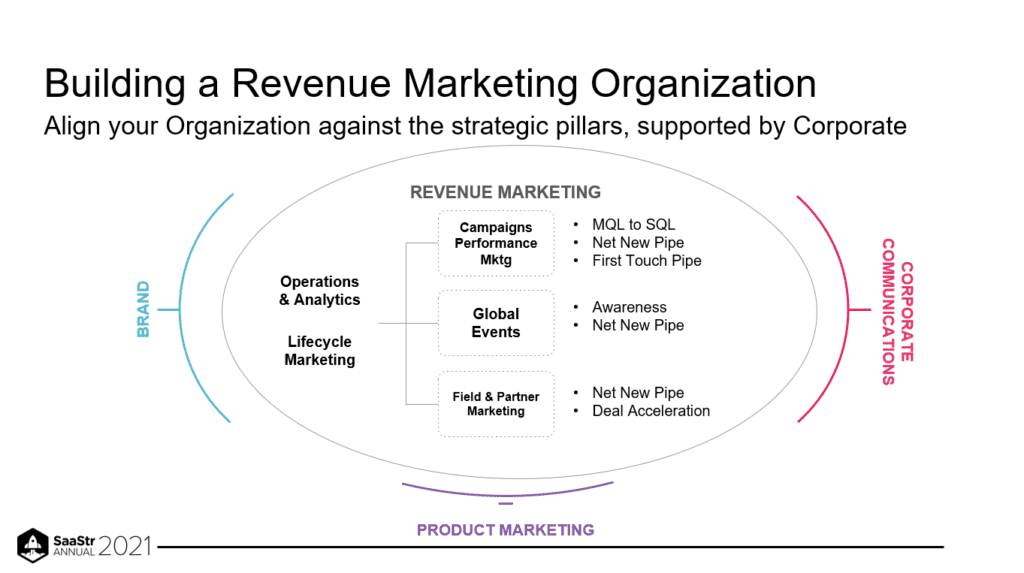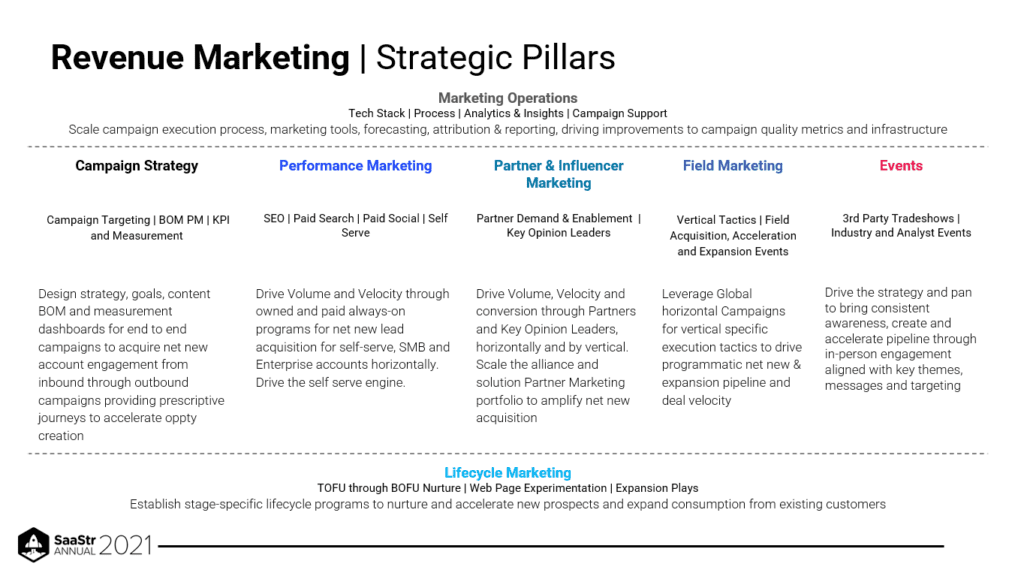Demand generation is the focus of targeted marketing programs that drive awareness and interest in a company’s products and or services. The ultimate success of demand generation is defined as the number of marketing qualified leads (MQL) generated, and is measured by impressions, website visits, and clicks.
Jess Weimer, Senior Vice President of Revenue Marketing at Podium, discusses why it’s time to pivot from demand generation to revenue marketing and best practices for making that pivot.

The purpose and limitations of demand generation
The original function of demand generation was about the top-of-funnel awareness and vanity metrics. But this narrow approach limits our ability to understand how to create a solid pipeline and inhibits us from understanding the end-to-end prospect journey. This leaves marketers looking at their tactics in isolation.
Demand generation is an antiquated discipline.
Marketing has evolved over the last couple of decades, which means the marketer’s purpose has evolved with it. Rather than operating on our own in silos, marketers must extend our focus beyond top-of-funnel metrics and partner with sales to create a pipeline velocity.

Pillars of Revenue Marketing
Successful revenue marketing requires connectivity between all the pillars or you’re not creating an integrated prospect journey. Weimer organizes her team at Podium by the seven pillars of revenue marketing:
- Marketing Operations: Marketing operations cover scaling of the campaign execution process, marketing tools, forecasting, attribution and reporting, and driving improvements to campaign quality metrics and infrastructure.
- Campaign Strategy: Campaign strategy involves design strategy, goals, content bill of materials (BOM), and measurement dashboard for end-to-end campaigns. The goal is to acquire net new account engagement through inbound through outbound campaigns. This provides descriptive journeys to accelerate opportunity creation.
- Performance Marketing: Performance marketing focuses on driving volume and velocity through owned and paid ‘always on’ programs for net new leads acquisition for self serve, SMB, and enterprise accounts horizontally.
- Partner & Influencer Marketing: Drive volume, velocity, and conversion through partners and key opinion leaders horizontally across each vertical. Scale your alliance and solution partner marketing portfolio to amplify net new acquisition.
- Field Marketing: Leverage global horizontal campaigns for vertical-specific execution tactics to drive programmatic net new leads, pipeline expansion, and increase deal velocity.
- Events: Create another channel of influx through in-person engagement events aligned with key themes, messaging, and targeting. Plan your strategy to bring consistent awareness through these events.
- Lifecycle Marketing: Establish stage-specific life cycle programs to nurture and accelerate new prospects and expand consumption through existing customers.

Evolving to Revenue Marketing
There are many ways to make the pivot from demand generation to revenue marketing. Any company can take these three specific strategic actions to begin moving toward revenue marketing.
1. Organizing your teams for revenue marketing
Revenue marketing requires cross-functional teamwork. You have to ensure that each team member is aligned with the strategic pillars of revenue marketing.
I want each member of my team to become a revenue marketer regardless of their core function.
To do that, take a close look at your team, your measurements, and your KPIs to assess where the gaps are. Gaps can show up anywhere – budget, content, talent, strategy, or operations. Once you’ve identified where the holes are, work cross-functionally and within your team to fill those gaps.
2. Creating an integrated prospect journey
Three measurements you want to focus on to effectively track your revenue marketing pipeline are volume, velocity, and conversion. Volume and conversion are well covered in all marketing lessons, but what they miss is velocity. Creating a true end-to-end integrated prospect journey from the top of the funnel to the bottom will accelerate pipeline velocity.
Begin doing this by understanding the voice of your customers and going deep into lost opportunities and closed-won data.
In other words, know why you win and fix why you lose.
For example, are we losing because we’re not creating enough stickiness at the top of the funnel? Is there a handoff problem? Are there messaging inconsistencies?
Doing a deep dive into the voice of a customer will help you discover and understand your customers’ greatest needs and their primary purpose for using your product. This can be done through a combination of interviews (win/loss, buyer, customer), listening to the market, and observing trends throughout the competitive landscape.
3. Affecting change in the sales ecosystem.
Revenue marketing should affect the entire ecosystem and therefore changes should happen in the sales process. Here’s how:
- Top-of-funnel programs- Top-of-funnel programs are primarily focused on building brand or product awareness. The programs for this funnel should focus on targeting personas based on the entry point to deals.
- Analytics or Insights- Revisit how you measure analytics. Revamp how you look at insights with a focus on the true sources for the pipeline you created.
- Full Funnel Marketing- Ideally, you want prospects to go through the funnel quickly. They may get stuck in the funnel and get disconnected from your company. Drive marketing programs across the entire funnel to accelerate the prospects’ journey throughout the funnel.
- SDR Qualifications- Coordinate a hand back to marketing for tire kickers. Tire kickers are people who appear interested in making a purchase but never do.
- Sales Pipeline and Forecasting- Focus on the middle and bottom of your funnel and programs. This will allow you to make better decisions and forecast results accurately.
Key Takeaways
The key takeaways are:
- Organize your team to be aligned with your strategic marketing pillars. Each role in your organization should be a part of the connective tissue that leads your team across the finish line with customers.
- Broaden your measurements to align with sales, in terms of velocity and conversion.
- Step outside your swim lane. In other words, partner with sales and tap into customer listening.
The end game of revenue marketing is not just to drive volume, but to create an end-to-end prospect journey that results in fast closure of deals and high conversion rates.

